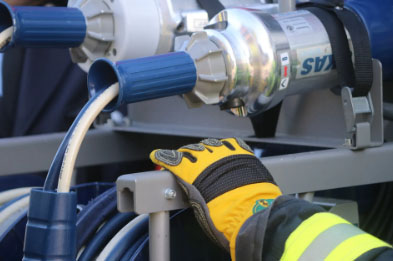When the hydraulic system stops working as expected, whether due to a major leak or a pump failure, it may stagnate productivity (literally and symbolically). The process of tracking the source of the problem involves troubleshooting, which requires a lot of skills, Experience and common sense, however, there are some effective guidelines and good tips that can help complete this process.
1. ready for troubleshooting:

System does not work
The step of effective troubleshooting is to ensure that you understand the problem. This may involve asking many questions. For example, if someone says "The pump vibration is very serious", you need to study the problem more deeply, such:
1) hydraulic pump filter maintenance.
2) How long has this been going on? When did it start?
3) What happened when you noticed it for the first time? (For example, system startup or shutdown, heavy load, sharp temperature change)
4) Have you made any changes to the system recently, such as maintenance, setting changes or repairs?
5) When was the last maintenance performed?
After collecting all possible facts, extract the hydraulic schematic diagram for reference-don't try to troubleshoot without this situation! The schematic provides valuable information about the flow and pressure in the system.
2. FAQ:
Some problems usually cause the hydraulic system to fail to work normally, such as the system cannot operate or the hydraulic oil is overheated. The following are some troubleshooting tips for typical problems in the hydraulic system.
1) The system does not work:
If the hydraulic system does not work, you can check a few things, verify the hydraulic oil level, and keep in mind that leaks will cause a large loss of hydraulic oil, look at the hydraulic filters, because if they are dirty or clogged badly, it will seriously affect performance, Check the restrictions in the hydraulic lines, the restrictions usually appear in the form of fold lines or blocked lines.
Make sure that there is no air leakage in the pump suction line, and check the pump itself; if it is worn, dirty or misaligned, it will affect system performance. If the belt or coupling slips or is damaged, it may be the cause of the pump drive problem, and it may be time to replace some components. When they start to wear out, they may cause internal leakage. It is also a good idea to ensure that the equipment is operating within the maximum load limit.
2) Slow operation:

Improving the reliability of hydraulic systems
When the hydraulic system starts to work slower than normal, one of the reasons may be that the hydraulic oil is too thick, which may be caused by low temperature or the use of inappropriate hydraulic oil. Since the hydraulic filter is dirty, the air trapped in the system and the restrictions in the pipeline are all a problem. Another potential problem is that the hydraulic components are severely worn, such as pumps, motors, cylinders and valves.
3) Unstable operation:
If the system is operating in an unstable, unpredictable manner, the most common causes are trapped air in the system, overcooled hydraulic oil (which means the equipment needs to be preheated before use), and damaged internal components such as bearings and gears.
4) Excessive noise or vibration:
Another common problem with hydraulic systems is excessive/abnormal noise or vibration. If it is a noisy pump, check whether the oil level is sufficient, the correct type of fluid used, and whether the oil is foamed. If the oil is foamy, it will point to the air in the fluid, which can cause cavitation and expensive damage. It is also wise to confirm that the inlet screen and suction line are not blocked. For pumps and hydraulic motors, there may also be internal problems, namely bearing wear or misalignment. And don't forget to make sure the coupling is firm and firm. Keep in mind that if the pipes and pipe clamps are not properly fixed, they may vibrate.
5) Hydraulic oil overheating:

Overheating is never a good sign in a hydraulic system and usually causes the system to be at a sub-optimal level. One of the purposes of hydraulic fluid is to dissipate the heat generated, but the system should not generate enough heat to make the fluid reach a high temperature.
There may be many reasons behind the high-temperature hydraulic oil. The first is contaminated hydraulic oil or the liquid level is too low. There may be too much oil passing through the overflow valve at one time; in this case, the control valve should be set to neutral when it is not used. Due to internal leakage, the wear of components in the system may also cause excessive temperature.
If there is a restriction in the pipeline or the filter is dirty, it will cause the hydraulic oil to become hot. If the hydraulic oil viscosity is too low, it may also cause overheating. Finally, it may be necessary to ensure that the oil cooler is working properly and the key components are clean enough to allow heat to dissipate from it.
6) Low viscosity:
We have discussed that low viscosity is a symptom, but it also has its own problems. When trying to determine why the fluid is not as viscous as it should be, the three things that need to be checked are damage to the oil (usually due to extreme temperatures or Aging), using the wrong type of hydraulic oil or water in the hydraulic oil, in all three cases, the system needs to be flushed and the oil changed.
7) Leakage:

Even a small leak over time can cause enough fluid loss to affect performance. If fluid can flow out of the system, harmful contaminants may enter the system. Most leaks are due to worn seals, damaged hydraulic lines, or poor connections. Finding the source of the leak can be challenging and dangerous. When the system is running, do not try to find the leak by hand, because high-pressure hydraulic oil can pierce your skin and sink underneath, causing so-called injection injuries, a quick and safe way to detect leaks is to use cardboard or plywood instead of hands. If the leakage comes from the motor or pump, the possible cause is that the seal or gasket is worn and needs to be replaced.
8) No fluid flow
No flow in the hydraulic system is a serious problem and may have several different sources. The step is to accurately determine where the fluid stops, for example, the pump cannot receive fluid at the inlet (usually the result of a blocked pipeline or a dirty strainer) or the fluid cannot flow out of the outlet. This may be due to the need to replace the pump motor, the shear coupling between the pump and the drive, or the pump/drive failure. It is also a good idea to ensure that the pump rotation is set correctly and the directional valve is in the correct position, the most expensive problem is a damaged pump that needs to be replaced or repaired.
3. conclusions:
The troubleshooting step is to collect as much information as possible about the problem, and then extract the hydraulic schematic of the system. From there, you will basically follow an elimination process until you find the source of the problem. However, other considerations about troubleshooting are Once you find the source of the problem, it may cause you to encounter another problem that needs troubleshooting, restoring the hydraulic system to normal operation can be a time-consuming process.
For example, you may find that the cause of hydraulic oil overheating is low viscosity-but why is the hydraulic oil not viscous enough? Before the problem was discovered, the troubleshooting process was not over. Take another pump as an example. The internal components of the pump have worn out and affected the performance of the entire system-why are these components worn out prematurely? This may be the cause of misalignment, insufficient lubrication or fluid contamination. A good hydraulic technician will not only track down and solve the problem, but also continue to troubleshoot to ensure that the problem does not happen again.










